Last-Minute NYC Holiday Gift Guide 🎁
We’ve created a holiday gift guide with presents for the intrepid New Yorker that should arrive just in time—


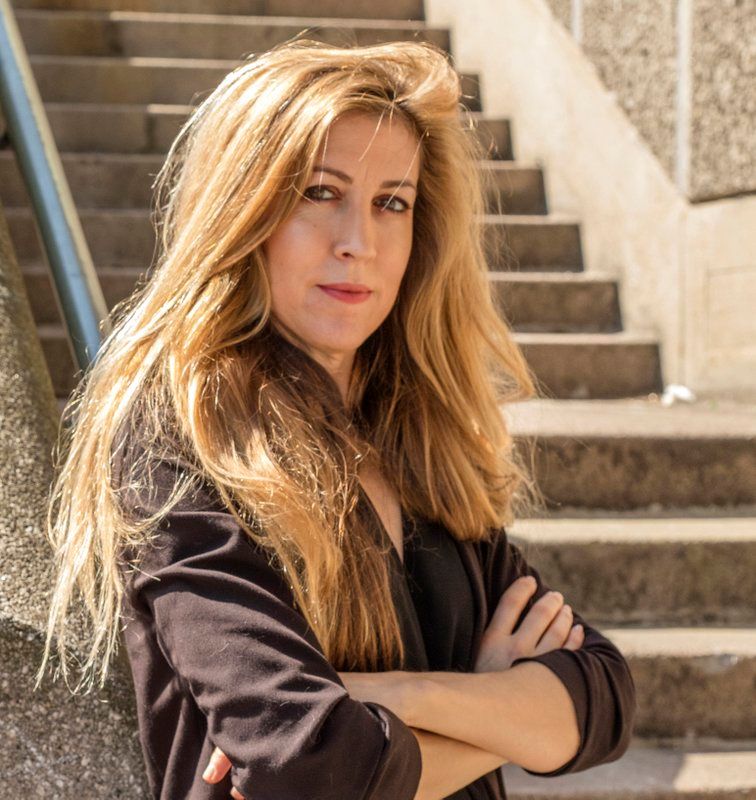 Harriet Harriss, Photo credit: Morley Von Sternberg
Harriet Harriss, Photo credit: Morley Von Sternberg
We recently sat down with the architect and writer, Dr. Harriet Harriss, the new Dean of the Pratt Institute School of Architecture in Brooklyn. The London transplant started at Pratt in the fall 2019 semester and shares with us her refreshing take on architecture education, New York City, and more. And she officially had the best answer to our question, “Name one surprising thing about yourself” we’ve heard yet in our NYC Makers series.
Harriet Harriss: I think that London and New York share particular challenges about the built environment. We have the same concerns about housing affordability. The same pressures for densification. The same flood risk that is only set to increase as a consequence of the climate crisis. So while both New York and London share the same cultural and creative leadership qualities, they also share some of the most existential challenges of our epoch. This is something I think makes us feel closer politically and practically than we are geographically. In terms of everyday life in New York, however, there are a few things I’m still coming to terms with. For example remembering that it’s not a Metro or a Tube, but in fact a subway, and just how the different taxes work here. Unlike the UK and the rest of Europe, the price on the label is not the same as the cost of the bill.
Untapped New York: And then the tip…
Harriet Harriss: Yes, exactly! And then the tip. What I also find intriguing is how guarded all of the street planters are, that every single planter has either an aggressive sign admonishing dog owners to ‘curb’ their pets, or it’s been colonized by someone who is desperately longing to cultivate the illusion of a garden oasis by installing miniature picket fences and bird feeders.
Untapped New York: That’s so funny. I never thought of that as specific to New York.
Harriet Harriss: It’s definitely a New York thing. Of course, there are other similarities, aside from the more playful examples. Both the UK and the US are contending with forms of political instability that are fueling new conversations about the responsibilities of education. While we have always been committed to connecting professional practice to the proto-practice of the design studio in order to sustain the profession in its current iteration, we now recognize that schools of architecture face far more profound obligations towards society, too, and that can’t limit our value to the production of qualifications. Instead, we need to de-partition our institutions from the communities in which we’re situated; better serve a diverse public and engage people who are otherwise underrepresented within our student cohorts, but who should rightly feel that they have some sense of entitlement to and ownership of the spaces of learning that offer personal and professional advancement.

Inside the Pratt campus
We’re now operating way beyond the notion that learning takes place in institutions, and then the application of that learning takes place in professional practice. That binary is deeply problematic. Instead, we situate our teaching and learning experiences across a range of local and international sites and in collaboration with community partners, businesses, agencies, institutions and design practices, in order to establish a kind of revolving door between the community and the classroom. This adds a sense of immediacy to learning because students can see the tangible impact of their growing expertise during their time at Pratt, rather than wait until a future when they are a fully-qualified professional.
Harriet Harriss:Pratt works with communities that are situated both locally and internationally. This is largely thanks to Pratt’s pioneering new president, Frances Bronet — who is a committed and talented inter-disciplinarian and who fuels institutional initiatives that support all forms of creative knowledge exchange. This is why some of Pratt’s most avant-garde thinking concerns how we might collectively address the planet’s most challenging problems. This is tied to a growing interest in democratizing knowledge – from process to product – in order to start thinking about how we might provide solutions that can resonate between beyond any one professional practice discipline, sector, or even region. So I think that’s really the culture we’re seeing emerge now in Pratt, which is why it’s such an exciting time to take on the role of a dean within such a dynamic institution.
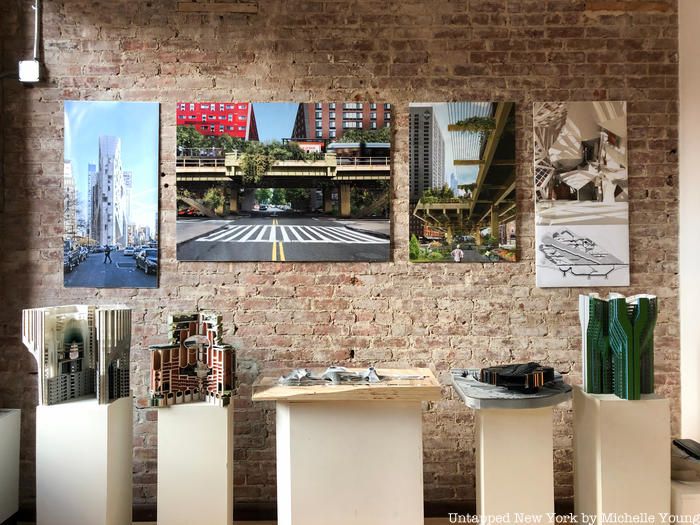 Student projects on display in Harriss’ office at Pratt. Images on wall from left to right: Mara Lookabaugh, Valeria Victoria, Valeria Victoria, and Benjamin Smithers; Prototypes from L to R: Sandra Nataf, Zhixian Song, Sandra Nataf, X Damianos, and Anthony Lee Mull
Student projects on display in Harriss’ office at Pratt. Images on wall from left to right: Mara Lookabaugh, Valeria Victoria, Valeria Victoria, and Benjamin Smithers; Prototypes from L to R: Sandra Nataf, Zhixian Song, Sandra Nataf, X Damianos, and Anthony Lee Mull
Untapped New York: It can be hard to change schools that have been doing something for so long…
Harriet Harriss: Large educational institutions are a lot like cruise ships in that they take a long time to turn around. For over a century, institutions have maintained a particular trajectory based upon very particular and often privileged understanding of what counts as knowledge. More recently however, there is a collective sense of resistance against what constitutes authority in any one discipline or field of practice and a recognition that we need to rethink whose interests these bodies of knowledge best serve? Everything about our curriculum’s assumed authority calls authorship into question. We are required to consider, whose voices have been captured in that curriculum and whose haven’t? Who is being privileged against who is been disadvantaged by these bodies of knowledge? To confront all of this, without leaving anyone behind, requires incredibly strategic approach. It can’t be a top down decision, but one that builds upon a fledgling momentum to recover the voices of those who have been marginalized, ignored or overlooked entirely.
Untapped New York: It’s interesting what you say about geography, because when I was an undergrad at Harvard in the early 2000s, I was studying architectural history and theory. And I was interested in urban planning, so I took one course at the GSD and it was their intro to urban planning class and all we studied was the Boston Big Dig and English Garden Cities. I put urban planning aside in my mind and thought, maybe the field isn’t for me. It wasn’t until I went abroad for work and saw cities like La Paz, Bolivia and Jakarta, Indonesia, that I realized, oh, urban planning can be beyond the United States, and must necessarily be. But as a young student, I didn’t even think to question what the curriculum was. I then got my masters in Urban Planning at Columbia’s Graduate School of Architecture, Planning, and Preservation where I’ve been teaching an urbanism studio about New York City for the last six years.
Harriet Harriss: When you Google ‘masters of architecture’ you don’t get many pictures of anything other than images of Caucasian men. I want my students to feel a sense of belonging in the school and the profession, so it’s time we changed that – and I’m not the only educator committed to being part of that change.
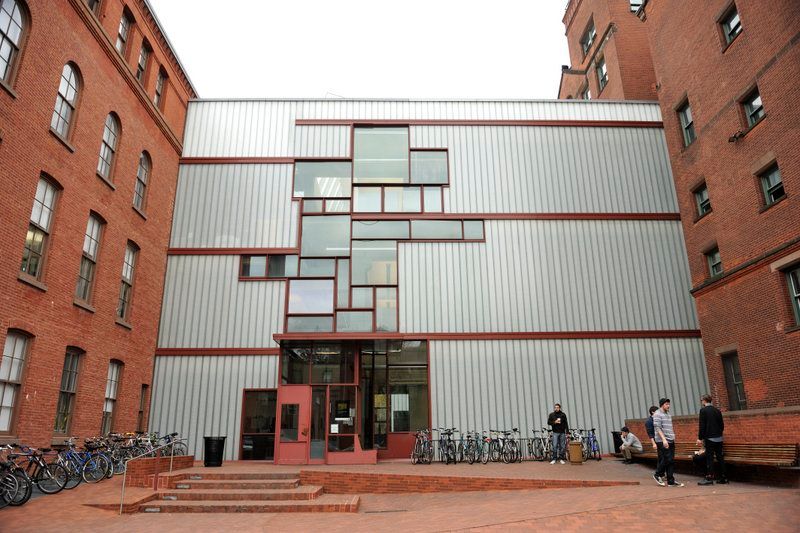 Higgins Hall at Pratt Institute School of Architecture. Photo courtesy Pratt Institute.
Higgins Hall at Pratt Institute School of Architecture. Photo courtesy Pratt Institute.
Harriet Harriss: The architecture and gender critique captured in some of my previous publications reflect some of the many bold aspirations I have for Pratt School of Architecture. Right now, we have a new curriculum committee who are exploring how we can meaningfully decolonize architectural education. One of the most important aspects of this committee is the diversity of its members – from adjuncts and emerging academics to people who’ve been at Pratt for half a century. There’s an assumption that decolonizing the curriculum involves either demolishing or abandoning established knowledge, but that isn’t the case. Instead, it involves a profound and honest critique of what constitutes established knowledge and an often challenging excavation and repatriation of forgotten knowledge. It also means looking at our pedagogies not just our curricula canon.
The processes involve extend far beyond gender balanced, or regional balanced reading lists, or employing the occasional minority juror. We need to start thinking really creatively about how we ensure people from communities who are not so far engaged in our education institutions, feel as entitled to be here as everyone else. We are therefore working towards designing that culture within in our school because we have to be really proactive.
Harriet Harriss: Pratt has always been an incredibly socially-engaged and industry hot-wired institute. Even our founder, Charles Pratt, came from a family of eleven children and grew up in poverty. He then used the wealth he generated from building oil refineries to create decent worker housing and educational facilities because he was convinced that believed that everyone had a right to a good home, an education and the opportunity for self improvement. In this respect, Pratt’s DNA has always resonated with my conviction that education is a transformation project, one that provides an opportunity for people to completely change their position in life and do something different with their talent, skills and determination. Pratt has always been proud of its Brooklyn roots and its positioning as a community institute. Pratt is increasingly celebrated as a maker institute, one that works easily between traditional craft and technological tools-based approaches – New York’s biggest industrial robot capable of design but also dance, gesture, mark making and film, based at our campus in the Brooklyn Navy Yard.
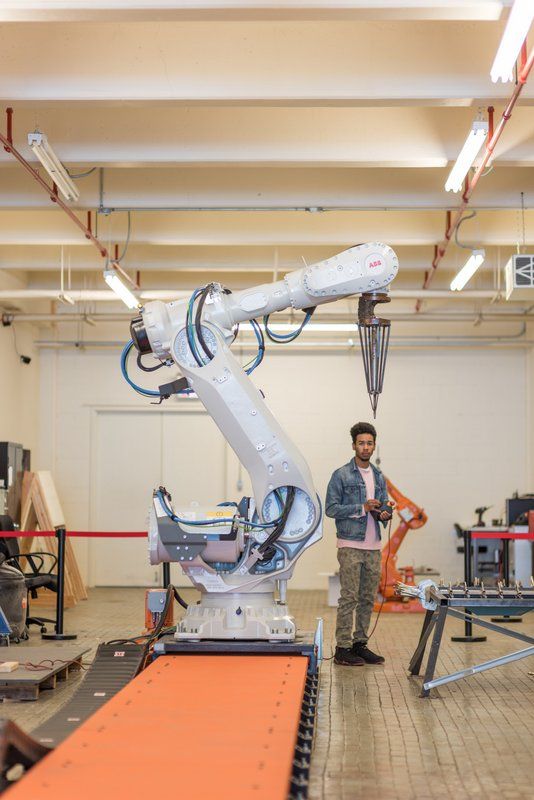 Pratt’s robot at the Brooklyn Navy Yard. Photo courtesy Pratt Institute.
Pratt’s robot at the Brooklyn Navy Yard. Photo courtesy Pratt Institute.
Pratt has always been interested in more kinetic forms of learning. For students who feel that they want to physically engage in the process of understanding something, who are interested in having a very prototype-led approach to tackling complex problems, whether they are historical or contemporary, or who want to use the maker process to solve philosophical and not just practical problems then Pratt is really the place. We also have a long history in connecting architecture to its ethical origins as a profession fundamentally committed to public service and not just private gain. Many of my faculty have worked tirelessly to address inequalities within the environment, or inequalities within society that have been reinforced by the built environment by unscrupulous architects. It’s the association with these projects that explain why architects are often underutilized in construction projects, or assumed not to be public allies. For many people, particularly those from lower-income communities, architecture is often seen as complicit in the agendas of the wealthy elite: too easily co-opted into the creation of exclusive follies and symbols of advance rather than stepping up to address some of the key spatial needs we have in the cities of today. This is why giving students a chance to reimagine architecture as a social project, allows them to confront the inequalities that the built environment has imposed upon people in both urban and rural environments. They are now questioning with whom does an architect’s loyalties lie? Who are architects’ people? Do client needs matter more than those of end users? How do we begin to work with communities who have often overlooked by architects and city planners for over half a century?
 Work by Sandra Nataf
Work by Sandra Nataf
One of the things I really enjoyed about coming to Pratt School of Architecture is that there is so much talent in the building – both students and faculty. The question becomes how best to develop and advance this talent, both individually and collectively, and connect it to a wider, international audience. And maybe that’s where being a British and Irish, European can prove useful l because I don’t just look at what Pratt is through a New York lens. I see the potential for wider forms of connectivity and collaboration, both across the disciplines, and across the world.
We then asked Dean Harriss some of our classic NYC Makers profile questions:
Harriet Harriss: Prospect Park, which was designed by the same landscape architects who designed Central Park – Frederick Law Olmsted and Calvert Vaux. In both contexts, the idea was to evoke a sense of natural landscape, even though it’s heavily curated, by appropriating icons of landscape design across a range of aesthetic genres and historic trends in landscape design. For architecture historians, the amalgamation of so many different styles and flourishes can reinforce the synthetic nature of the landscape but then, being able to run through a mini-woodland in the middle of the city more than makes up for it.

Prospect Park. Photo courtesy Harriet Harriss
My favorite spot is the Prospect Park Dog Beach. Even the very notion of a dog beach is distinctly American. I run here in the mornings, and typically arrive when the sun comes up in the east, outlining the dog’s wet fur in golden light, rendering the entire scene with a flourish of light and movement that much resembles an Impressionist painting.
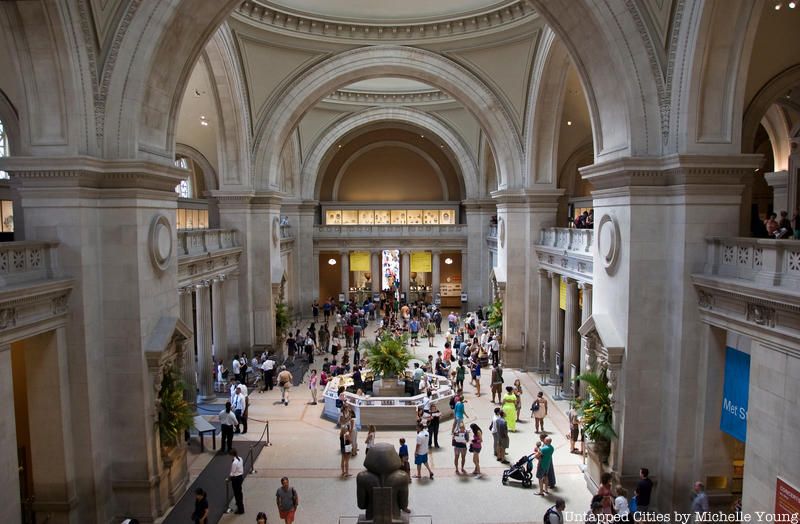 The Metropolitan Museum of Art
The Metropolitan Museum of Art
Harriet Harriss: I think one of the things that’s wonderful about New York is its museum collections. For many museums collections are expensive to store and maintain. In the UK for example, arts funding helped to ensure museums remain public and free to attend. Following funding cuts, some collections have started selling artifacts just in order to survive. In contrast, The Metropolitan Museum of Art is the fourth largest museum in the world, covering an area of 633,100 square feet that houses over two million objects. Of course, the philanthropy that fueled the creation and expansion of The Met doesn’t negate the need for government investment in arts and culture. Europeans are especially convinced of the need to avoid confusing philanthropy with privatization.
Harriett Harriss: I’m working on another book entitled Architects After Architecture, that was prompted by an acknowledgement that the majority of architecture graduates in the US and UK and across Europe will never become architects. Instead, they’ll take their exceptional architectural skill set and go off and do amazing things in other sectors and industries. So the book provides a catalog of all these different people – from famous actors and musicians to film makers and tech developers, to reassure graduates that there are all kinds of industries outside of architecture, where their skills are highly desirable and sought after. The designer Tom Ford is one example — he’s a hugely successful film director, fashion designer and perfume designer — but studied architecture. He is one of many people who prove how valuable an undergraduate degree in architecture can be. It’s not just the intensive, studio-based design projects. It’s the richly diverse, epistemological framework of architecture, that blends humanities, mathematics, the arts and sciences into one comprehensive and rigorous confection. Blend these qualities with the alchemy of three dimensional problem solving and problem-based learning taught in the design studio and students have both the behaviors as well as the skills needed to adapt to but also invent their own niche market opportunities as easily as they might choose to follow a more conventional career path.
Harriett Harriss: I’ve got a full motorbike license that entitles me to drive a motorbike up to the size of an 1100cc engine, the same as police motorbike. During my childhood, I was routinely admonished doing things that were considered ‘dangerous’, and there was definitely some gender bias in play. So as soon as I reached adulthood, I jumped out of airplanes, became a rock-climbing instructor, a cycling coach and taught kayaking….the list is possibly too long, but it really came down to me always wanting to find the edge – but only on my own terms.
On a visit to the Pratt campus in Brooklyn, don’t miss the all the incredible world-class artwork in its outdoor sculpture garden, the steam plant or the shingled cat houses!
Subscribe to our newsletter